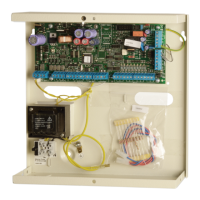10 / 18 P/N 466-5570 (EN) • REV E • ISS 22MAR22
Power supply specifications
Type A per EN 50131-6
Type I per VdS 2115
1.10 A max. at 13.8 V 0.2 V
2.10 A max. at 13.8 V 0.2 V
2.65 A max. at 13.8 V 0.2 V
Main board consumption (Alarm / Idle):
Maximum system current available [2]:
1000 mA at 13.8 V ±0.2 V
2000 mA at 13.8 V ±0.2 V
1950 mA at 13.8 V ±0.2 V
2500 mA at 13.8 V ±0.2 V
Auxiliary power output (AUX.
POWER) [3]
Battery power output (BAT) [4]
13.8 V 0.2 V, 2.5 A max.
Lead acid rechargeable: [5]
7.2 Ah, 12 V nom. (BS127N)
12 Ah, 12 V nom. (BS130N)
18 Ah, 12 V nom. (BS131N)
26 Ah, 12 V nom. (BS129N)
36 Ah, 12 V nom. (BS134N)
Standby use battery life [6]:
Typical
Maximum
3 years under 20°C floating
charge condition
5 years
200 cycles at 100% discharge
225 cycles at 80% discharge
500 cycles at 50% discharge
Maximum voltage at power supply,
auxiliary power output and battery
power output
Minimum voltage (battery
recharging) at power supply,
auxiliary power output and battery
power output [8][9]
Maximum ripple voltage V, p- p [10]
100 mV typical, 300 mV max.
Overvoltage trigger value [11]
Power unit failure voltage
[1] The power supply voltage is monitored according EN 50131
Grade 3 and VdS-C regulations.
[2] Current available for auxiliary power and battery charge outputs.
[3] Maximum permanent current to power devices external to the
control equipment in the absence of alarm conditions. The sum of
the auxiliary and COMM power output current cannot exceed the
maximum current specified in “Auxiliary current and battery
capacity” on page 11.
[4] Battery output provides battery shortcut protection (according to
VdS requirements).
[5] The housings applicable for particular batteries are specified in
“Auxiliary current and battery capacity” on page 11.
[6] High temperature and multiple charge cycles may greatly reduce
battery life time. See the specifications for your battery for more
information.
[7] If during a manual or a programmed battery test the battery
voltage drops below this threshold, the battery test fails.
[8] Deep discharge protection mechanism monitors the battery
voltage and disconnects the battery if the voltage falls below
indicated value, as required by EN 50131 Grade 3 and VdS-C
regulations.
[9] A specific fail message is generated when any output fails.
[10] Max ripple voltage only when empty battery is charging.
[11] Overvoltage protection mechanism monitors the power supply
voltage and shuts down the PSU if the voltage raises above
indicated value, as required by EN 50131 Grade 3 and VdS-C
regulations.
From 10,000 (4 digits) to 10 billion
(10 digits)
1 kΩ, 1.5 kΩ, 2 kΩ, 2.2 kΩ, 3.3 kΩ,
3.74 kΩ, 4.7 kΩ (default), 5.6 kΩ,
6.8 kΩ, 8.2 kΩ, 10 kΩ
8 (expandable to 16 with 1X ATS608)
5 (expandable to 9 with 1X ATS624, or
to 21 with 1X ATS626).
See “Standard onboard outputs” on
page 11.
Maximum keypad / RAS
number
Maximum expander / DGP
number
[1] It is necessary to install ATS670 second RS485 LAN extension
module to connect more than 16 RASes and 15 DGPs.
Maximum user number (for
users with SMS and voice
reporting functionality)
2000, which includes:
-1000 full data users
-1000 card-only users
Inhibit / isolate / shunt limit,
max.
24500, which includes:
- 10000 mandatory events
- 1500 non-mandatory events
- 10000 access events
- 1000 installer events
- 1000 dialler events
- 1000 extended events
Data retention (log, program
settings)
Door controllers supported

